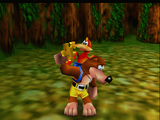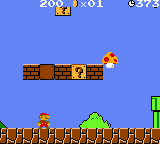The timeline for Ohga Shrugs is broken into several sections.
- Timeline (Ohga Shrugs to 2000)
- Timeline (2001 to 2006)
- Timeline (2007 to 2012)
- Timeline (2013 to Today)
1991[]
- June 20 - Nintendo unexpectedly breaks a deal with Sony to create a CD-ROM attachment for the Super Nintendo. Sony President Norio Ohga is outraged, but ultimately decides to let it go.
- June 23 - Sonic the Hedgehog is released for the Sega Genesis. The game's popularity soon leads to Sonic becoming Sega's mascot to rival Mario.
- August 23 - The Super Nintendo Entertainment System is released in America.
- December 1 – The Sega-CD is released as a Sega Genesis peripheral. It is never considered a success.
1992[]
- April 11 – The SNES is launched in Europe
- April 27 - Kirby's Dream Land is released, launching a popular new Nintendo franchise.
- May 5 - Wolfenstein 3D is released for the PC, starting a revolution of First-Person shooter games.
- June 10 – The first version of Street Fighter 2 is released for the Super Nintendo.
- August 27 - Super Mario Kart is released, starting the most successful racing series of games ever made.
- November 21 - Sonic the Hedgehog 2 is released for the Genesis. It goes on to become its best selling non-bundled game.
1993[]
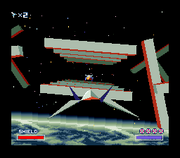
Star Fox was a great step forward in 3D games on consoles.
- February 21 - Star Fox is released for the Super Nintendo. The game is the first major true-3D game from Nintendo.
- February - Development of the Sega Saturn begins.
- May 15 - Final Fight 2 is released for the SNES. The game is a sign of slowly changing times, as Capcom created no arcade equivalent to this once arcade-based franchise.
- July 11 - Goof Troop is released in America. This licensed game from Capcom is the first title to be designed by Shinji Mikami.
- September 23 - Sonic CD, the most notable Sega CD game, is released. Despite the game's critical acclaim, it sells little hardware.
- September 24 - Myst is released for computers. It becomes one of the best selling computer games of all time, eventually taking the crown for best selling computer game ever for a couple of years.
- October 4 - The 3DO console is released. However, due to its high price of $699 and lack of support, the system is soon discontinued.
- October 5 - Mega Man 6 is released for the NES. After over a decade of support, this unofficially marks the end of the system's life.
- October 14 – Ridge Racer is released in the arcades. The game does not come to home consoles.
- November 15 - Atari releases the Jaguar console. Although powerful, the system proves to be a commercial failure, and is the last American console ever made.
- December - Sega releases Virtua Fighter for the arcades, sparking the 3D gaming revolution.
- December 17 - Capcom releases Mega Man X for the SNES. This game marks the series' belated yet successful step into the next generation.
1994[]
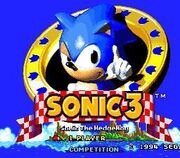
The Sonic series maintained a high level of praise and sales throughout the early 90's.
- February 2 - Sonic the Hedgehog 3 is released.
- March 19 - Super Metroid is released for the SNES. The game goes on to define a sub-genre of games.
- March 26 - Daytona USA is released in the arcades. The game is acclaimed for its advanced 3D racing.
- April 21 - The Ultra 64, later renamed the Nintendo 64, is first shown to the public.
- April - Camelot Software Planning is created out of the defunct Sonic! Software Planning studio. Camelot continues to make games for Sega.
- September 9 - Mortal Kombat 2 is released for the Super Nintendo, with all of the gore and fatalities intact.
- November 14 - X-Men: Mutant Apocalypse is released. It is the first of several notable games from Capcom based on Marvel Comics licenses.
- November 21 – The 32X is released in the West. 6 games are ever made for it, and the peripheral is almost universally deemed a failure.
- November 21 - Donkey Kong Country is released for the Super Nintendo. This new series helps the Super Nintendo do well in its latter years.
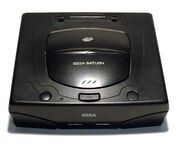
Unlike in our timeline, the Sega Saturn proves to be a major step forward for Sega in the console market.
- November 22 – The Sega Saturn is released in Japan. The key launch title is Virtua Fighter, which goes on to be the dominant fighting franchise on the platform.
- November 28 - Killer Instinct is released by Rare in the arcades. It is ported to the SNES the next year.
- November 30 - Hideo Kojima famed Adventure Game Snatcher is released in the west as an exclusive for SegaCD, the game would become a cult classic but start the long term relationship between Kojima and Sega
- December 9 – Tekken is released in the arcades. This series does not come to home consoles the entire 5th console generation.
- December 16 - Mega Man X2 is released for the SNES.
1995[]
- March 17 – Panzer Dragoon is released for the Saturn.
- March 24 - Mega Man 7 is released for the SNES. Unlike the X series, this game looks back to the past rather than embracing new ideas in game design.
- April 1 – Daytona USA is released for the Saturn.
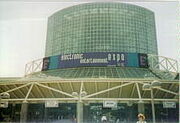
The original Electronic Entertainment Expo.
- May 11 - The first Electronic Entertainment Expo (E3) is held in Los Angeles. Launch details for the Sega Saturn are given, while Nintendo reveals that it will release its next system in 1996.
- June 5 - Street Fighter Alpha is released in the arcades. The first truly new Street Fighter game since 1991, the game uses concepts and animation similar to that found in other contemporary Capcom games, like Darkstalkers and X-Men: Children of the Atom.
- June 6 - Star Fox 2 is released in Japan. Unlike other entries in the series, this entry uses real-time strategic elements, placing an emphasis on protecting the home base Corneria. Though this game is not as well received as the original, elements from it returned in future entries.
- June 26 - Donkey Kong Land is released for the Game Boy. It is followed up with sequels in in 1996 and 1997.
- August 15 - Highly Responsive to Prayers, the first game in the Touhou series, is released. The series eventually gains a strong following in Japan, especially once the games start getting ported to Sega's consoles.
- September 2 – The Sega Saturn is released worldwide at a price of about $299. Key launch titles include Virtua Fighter(Based in OTL Remix Version) Daytona USA and Panzer Dragoon.
- September 9 - The Neo Geo CD is launched.
- November - Virtua Cop Bundled with Sega Saturn Stunner is another major title, and is the leading on-rails shooter of the era.
- November 21 - Donkey Kong Country 2 is released for the SNES.
- December 1 – Virtua Fighter 2 is released. The game goes on to become the Saturn’s best selling game. Megaman X3 is released for the Super Nintendo, and is the last Main Megaman Game for Nintendo Until the Game Boy Advance. The game would later be ported to the Sega Saturn.
- December 12 – Sega Rally Championship is released. This revolutionary racer, which allows for different surfaces to have different properties, is the primary Saturn racing game.
1996[]
- January 19 – A port of Street Fighter Alpha is brought to the Saturn.
- January 25 - Guardian Heroes is released for the Saturn.
- February 27 - Pokemon is released in Japan. The first generation of games breathes new life into the aging Game Boy, and, when combining versions, becomes Japan's best-selling retail game of all time.
- March 9 - Super Mario RPG is released for the SNES. It marks the continuation of cooperation between Nintendo and Square going into the next generation.
- March 22- Panzer Dragoon II Zwei is released for the Saturn, with the addition of the Berseker Attack and the introduction of alternate routes become a even better recived that the original.
- April 30 – Rayman is released for the Saturn. It becomes the #1 2D platformer for the system.
- May 3 – Resident Evil is released for the Saturn. It helps define early 3D gaming.
- May - Policenauts is released for the Sega Saturn in North America with Support for Sega Saturn Stunner, the game would only become noticed when Metal Gear Solid was released and become a Collector Item.
- May 16 - E3 1996 is held. The event continued to gain prominence, establishing its place as the preeminent video gaming trade show in the United States. Nintendo showed off the Nintendo 64 using Super Mario 64, Pilotwings 64, Goldeneye 007, and a demo of Square's Final Fantasy VII. The American release date of September 26 is revealed, as is the launch price of $250. Donkey Kong Country 3 is also shown, as is the recently released Super Mario RPG. Saturn games shown include Crash Bandicoot, Tomb Raider, and Virtua Fighter 3.
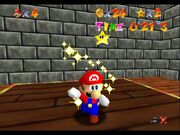
Despite its primitive graphics, Super Mario 64 proved to be revolutionary in terms of 3D environments.
- June 22 - Quake is released for the PC. The game is one of the defining games in PC history, with its 3D environments and extensive multiplayer options.
- July 5 – Nights into Dreams Bundled with Sega Saturn 3D Pad is released by the Sonic Team for the Saturn. Although a critical darling, it is no Sonic.
- July 21 - Mole Mania is released for the Game Boy. It ends up becoming one of Shigeru Miyamoto's most obscure works.
- August 4 - Tetris Attack is released for the Game Boy and SNES. It is notable as the first Puzzle League game to come West, albeit advertised as a Tetris game.
- August - Gunpei Yokoi temporarily leaves Nintendo. However, he returns in 1997 as an adviser and mentor.
- September 8 – The Nintendo 64 is released in Japan with Super Mario 64. This game helps define three-dimensional navigation and interaction in virtual spaces. Pilotwings 64 is the other notable launch game.
- September 9 – Crash Bandicoot is released for the Saturn. This third party game, published by Universal Interactive Studios, becomes the Saturn’s answer to Mario.
- September 20 – Sakura Taisen is released in Japan. This popular dating sim series makes it big in that country, but is never brought West.
- September 20 – Wave Race 64 is released.
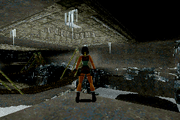
Tomb Raider became one of the Saturn's leading franchises.
- October 11 – Tomb Raider is released for the Saturn. It becomes one of the system’s premiere franchises.
- November - The first DVD movies are released in Japan. The DVD would eventually become a major format for retail games.
- November 14 – The Nintendo 64 is released in North America at $250. The Saturn’s price is cut to $250.
- November 22 - Donkey Kong Country 3 is released for the SNES. It is one of the last major games for the system. On the same day, Rare also releases a port of their arcade title Killer Instinct 2 to the N64, renaming it Killer Instinct Gold. It is their first of many N64 titles.
- November 30 - Street Fighter EX is released in the arcades. This game is Capcom's attempt at creating a 3D fighter. Although by no means a failure, this does not prove to be the future of the series.
- December – Fighters Megamix is released for the Saturn. The game combines aspects of multiple Sega fighting games in a King of Fighters-like fashion.
- December 7 – Mario Kart 64 is released in Japan. The game easily becomes the best selling racer on the N64.
- December – Star Wars: Shadows of the Empire is released. Although a moderate hit, it merely hints at later great games like Goldeneye and Star Fox 64.
1997[]
- January – Final Fantasy 7 comes out in Japan for the N64, followed by a worldwide release later in the year. As an N64 exclusive, it is radically different from our timeline’s Final Fantasy 7. Character models are more developed, but lack the same level of detail in environments. The same character models are used in and out of battle, and load times are mostly eliminated, but the world is smaller, there is less music, and cinematics are kept to a minimum. The resulting project is significantly smaller (a 20 hour RPG rather than a 40 hour one), but more concentrated and coherent. Although a hit in the west, the series does not reach true superstardom like in our timeline.
- February 4 - Street Fighter 3 is released in Japanese arcades. Unlike its predecessor, this game is a more subdued success, limiting the future of the franchise for years.
- March 1 – The N64 is released in Europe
- March - Castlevania: Symphony of the Night is released for the Saturn. The game is one of the few successful fully 2D titles of the fifth console generation, and is even rarer in that it was allowed to be released in the West.
- March - Tekken 3 is released in the arcades. This game's popularity gives the aging arcades a breathe of fresh air, allowing them to prosper for longer than in our timeline.
- March 18 - Kirby's Star Stacker is released for the Game Boy.
- March 21 - Blast Corps is released for the N64.
- April 1 - The original episode of the Pokemon Anime is aired in Japan. The show would go on to air for hundreds of episodes, and continues to this day.
- April – Star Fox 64 is released, returning to the relatively linear style of the first game. It features Rumble Pack compatibility, which is later used as an option in other games as well.
- May – Saturn and N64 prices are cut to $199.
- May 16 - E3 1997 is held. The theme of this show is shooter games, as many renowned shooters are shown. These include Goldeneye 007, Half-Life, and Unreal. Other major games include Starcraft and Diablo from Blizzard, Resident Evil 2 from Capcom, Tomb Raider II from Eidos, Metal Gear Solid and Castlevania: Symphony of the Night from Konami, Banjo-Kazooie and The Legend of Zelda: Ocarina of Time from Nintendo, Panzer Dragoon Saga from Sega, Final Fantasy Tactics from Square, Grand Theft Auto from Take-Two, and Dead or Alive from Tecmo.
- June - Final Fantasy Tactics is released for the N64, and becomes the best selling 2D game on the system, as well as one of the best-selling RPGs.
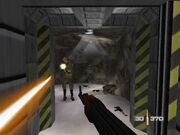
Although very popular on the N64, Goldeneye failed to spark an explosion of console FPS games.
- August 1 - Mega Man X4 is released for the Saturn. Although the game's predecessors were on the competing SNES, the Saturn was chosen based on its 2D graphics and lower costs of manufacturing retail copies of games.
- August 23 – Goldeneye is released for the N64. The popularity of the first major console FPS draws in a lot of older gamers, especially due to the multiplayer.
- September – Super Robot Taisen F is released for the Saturn in Japan. Like many popular Japanese Saturn games, it never leaves the country.
- October 15 - Age of Empires is released for the PC. It starts a popular Historical RTS series.
- November 21 – Diddy Kong Racing is released. It essentially feeds off of and expands upon Mario Kart’s success.
- November – Tomb Raider 2 is released. It becomes one of the best selling action games on the Saturn.
- December – Yoshi’s Story is released for the N64. The game sells well enough, but has a poor critical reception largely due to its brevity.
- December - Crash Bandicoot 2 is released for the Saturn. It goes on to become the best selling 3D platformer on the system.
- December - Diakanta, the first game from Ion Storm, is released. Though by no means a sales disaster, it sells less than creator John Romero hoped for.
- December 11- Shining Force III Scenario 1 is released for the Saturn, being the third game divided in third episode was a new aproach, with chance of playing mutiple routes, the Western release would be the Next year.
- December 18 - Mega Man Legends is released for the Saturn. The first 3D entry in the series, it is well-received, but overshadowed by earlier Mega Man games. The low quality of the Saturn's 3D effects does not help.
1998[]
- January 21 - Resident Evil 2 is released for the Saturn. This game goes on to become the best selling game in the series and the best selling horror game of all time for years to come.
- January 29 - Panzer Dragoon Saga was Released for the Saturn, the game being the mix of the traditional Shooter Panzer Dragoon with a full RPG become a fan and cult Classic and one of the most acclaimed RPG of the Saturn.
- February - 1080° Snowboarding is released for the N64.
- March 2 - Wario Land 2 is released for the Game Boy.
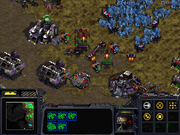
Starcraft helped bring the RTS genre into the limelight on PC's.
- March 31 - Starcraft is released for the PC. The game, though far from the first Real-time strategy game on the platform, is widely considered the best the genre has to offer. Starcraft would become a staple of competitive gaming.
- April 6 - Star Fox Adventures debuts on Japanese television. This anime series runs for 23 episodes, and becomes a cult hit among fans of the series.
- April 29 - Shining Force III Scenario 2 is released, this become the most sought part for his demand and rarity.
- May 11 - ZDTV, a cable television network focusing on technology, is initiated in the United States.
- May 28 - E3 1998 is held. As 1998 is widely considered one of the great years in gaming history, this E3 had many notable titles shown. Nintendo's first party lineup included Banjo-Kazooie, The Legend of Zelda: Ocarina of Time, Pokemon, and the Game Boy Color. Sega's titles include House of the Dead, Shining Force III Scenario 2 & 3 and Burning Rangers. Third party games include EA's Black & White, Konami's Metal Gear Solid and Silent Hill, LucasArts's Star Wars: Rogue Squadron, Microsoft's Age of Empires II, and Square's Final Fantasy VIII.
- June 29 – Banjo-Kazooie is released. It is arguably the greatest 3D platformer on the N64, a platform known for its 3D platformers.
- June - Project NAOMI is unveiled by Sega. It is later revealed to be their next-generation hardware, eventually named the Dreamcast.
- July 14 - F-Zero X is released for the N64. It is well received, but is overshadowed by kart racers on the N64, possibly dooming the franchise.
- August – Console prices are cut to $149.
- August - Anachronox is released. It is widely considered to be the first successful Japanese-style RPG made by an American developer. Though praised for its story, battle system, and puzzles, the game's graphics were considered outdated.
- September - Sega purchases Camelot Software Planning
- September 5 - An anime inspired special edition of Pokemon titled Special Pikachu Edition, aka Yellow, is released in Japan.
- September 17 – Spyro the Dragon is released for the Saturn.
- September 23 - Shining Force III Scenario 3 is released for the Saturn, For Players who collected all Three volumes, SEGA & Camelot issued a Premium Disc Featuring Artwork, a characther models gallery, a mini documental about the making of Shining Force III and other extras.
- October – Metal Gear Solid is released for the Saturn.
- October 14 – The Game Boy Color is launched at about $80. Despite launching with a deluxe version of Tetris, it is overshadowed by the Pokemon phenomenon. The system is replaced in just a few years, and is fairly quickly discontinued.
- November – The Legend of Zelda: Ocarina of Time is released. The game is just as big a deal as it is in real life, if not more so.
- November – Crash Bandicoot 3 is released.
- November – Virtua Fighter 3 is released for the Saturn.
- November 19 - Half-Life is released for the PC. In addition to pushing forward storytelling in shooter games, the title also puts the fledgling Valve on the map.
- December 1 - A colored port of The Legend of Zelda: Link's Awakening subtitled DX is released for the Game Boy Color.
- December 5 - Hey You, Pikachu! is released for the N64 in Japan. The game isn't released in the West until 2000.
- December - Custom Robo is released for the N64. It starts a minor Nintendo franchise.
- December - Star Wars: Rogue Squadron is released for the N64. Along with Star Fox 64, it is the most notable flying game of the generation.
- December – Mario Party is released to good sales and some praise. It starts yet another multiplayer series for Nintendo systems.
1999[]

Super Smash Bros launched arguably the most popular fighting series in gaming.
- January – Super Smash Bros is released for the N64. The game joins the library of multiplayer titles the N64 has become known for, and becomes the best selling fighting game on the system.
- January 31 - Silent Hill is released for the Saturn.
- February 11 – Final Fantasy 8 comes out for the N64.
- February 13 - Power Stone is released in the arcades. One of the first major games for Sega's NAOMI hardware, it is a showcase of what the next generation could bring. Despite plans to do so, neither this game or its sequel would be brought to the Dreamcast. However, upon the dissolution of the game's development team, Sega would hire its members to create "Team Smackdown."
- March – Pokemon Snap is released. Despite its brevity, it becomes the second best selling on-rails shooter on the N64, following Star Fox 64.
- March 16 - The Neo Geo Pocket Color is released in Japan. Although by no means a hit, it helps establish the Neo Geo brand as a competitor to the Game Boy series.
- April – Pokemon Stadium is released. The game helps breathe life into the aging N64, preparing it for the onslaught of the Dreamcast.
- April 20 - The Columbine High School Massacre takes place. In the aftermath, PC games are placed under scrutiny as a potential cause of the violence. Although little evidence comes to support this notion, this is the beginning of a wave of anti-game backlash.
- May – Star Wars Episode 1 Racer is released to critical acclaim and sales success on the N64. It is later ported to the upcoming Dreamcast.
- May 13 - E3 1999 is held. Sega reveals their upcoming Dreamcast, which would usher in the next generation of consoles. First party titles include Sonic Adventure and Shenmue. and Nintendo, although confirming their next system's existence, kept the focus on their current console. Nintendo games shown included Donkey Kong 64, Pokemon Stadium, and Super Smash Bros. Other games shown include Activision's Tony Hawk's Pro Skater, Blizzard's Diablo II, Capcom's Resident Evil 3 and marvel vs. Capcom, EA's The Sims, Microsoft's Age of Empires 2, Namco's Soul Calibur, and Ubisoft's Rayman 2.
- May 17 - Super Mario Bros. Deluxe is released for the Game Boy Color. A port of the original game, with the Lost Levels sequel and a variety of other content thrown in, this game is very well received.
- June - Sonic Golf, the first of several "Sonic Sports" games from Camelot, is released for the Saturn.
- July 1 - Dino Crisis is released for the Saturn.
- July – Driver is released for the Saturn
- July – Seaman is released for the Saturn alongside a microphone peripheral. It becomes a cult hit.
- August - Tony Hawk's Pro Skater is released for the N64. This franchise becomes one of the prominent sports series in gaming up through the following console generation.
- September – The N64 and Saturn's price are cut to $129.
- September - The Game Boy Micro is released. This version of the Game Boy requires a single AAA battery to power, and has all the features of its larger predecessors. Although incapable of playing Game Boy Color games, the system sells decently.
- September 22 - Resident Evil 3 is released for the Saturn.
- September 23 - Crash Team Racing is released for the Saturn.
- September 30 - Age of Empires 2: The Age of Kings is released for the PC. It is considered by many to be among the greatest RTS games ever made.
- October - Rayman 2 is, controversially, released for the Nintendo 64, a platform that previously had no Rayman games. Rayman 2 is considered by many to be the best 3D platformer of the generation not by Nintendo or any of its affiliates.
- October 24 - Spyro 2: Ripto's Rage is released for the Saturn.
- October - Xenogears is released for the Saturn.
- November 11 - Chrono Cross is released for the Nintendo 64.

The second generation of Pokemon games was only slightly less popular than the first.
- November 21 - Pokemon Gold/Silver is released in Japan, followed by releases in other countries up through 2001. Selling only somewhat less than the first generation of Pokemon games, Gold/Silver easily sells more than any other Game Boy Color game.
- November 24 - Donkey Kong 64 is released. The game required a special expansion pack for increased RAM, like the latter Majora’s Mask. Nonetheless, it sells well.
- December 17 - Mario Party 2 is released for the N64. Years later, it is still regarded as possibly the greatest title in series history.
2000[]
- February – Dead or Alive 2 is released for the Saturn.
- February 4 - The Sims is released for the PC. This starts one of the best selling franchises on the history of the platform, due to the wide demographic appeal in the series's nature.
- March - Kirby 64: The Crystal Shards is released. It is the odd 2.5D platformer on a system dominated by 3D platforming.
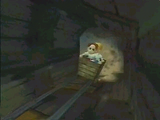
Earthbound 64, aka Mother 3
- March 21 - Earthbound 64, aka Mother 3, is released to critical acclaim and decent sales. The game is notably darker than its predecessors, containing elements such as drug-induced nightmares, depression, and suicide. It thus earns itself a "Mature" rating in the United States, a first-time event for a Nintendo game.
- March 28 - Wario Land 3 is released for the Game Boy Color.
- April – The Legend of Zelda: Majora’s Mask is released. It suffers from lower sales than Ocarina of Time due to the need for a peripheral.
- May 11 - E3 is held. This is the final E3 before the sixth generation of consoles. Sega shows off their launch line up, including Sonic Adventure, Crazy Taxi, Jet Set Radio, Samba de Amigo, and Shenmue. Nintendo reveals their GameCube, announcing its approximate release date of latter 2001. The last full round of N64 games shown at E3 included Banjo-Tooie, Conker's Bad Fur Day, Kirby 64, and Majora's Mask. Third party games shown include Blizzard's Warcraft 3, Konami's Metal Gear Solid 2, and Square's Final Fantasy IX.
- May 22 - Perfect Dark is released for the N64. It continues the FPS tradition started by Goldeneye.
- June 26 - Deus Ex is released for the PC in Europe and North America. By combining action, role-playing, and stealth elements, this first-person shooter is remembered as one of the all-time greats.
- June 30 - Excitebike 64, as developed by Left Field Productions, is released.
- July - Sonic Tennis is released for the Saturn. It is one of the last major games for the system.
- July – Dragon Quest 7 is released for the N64. The game helps the N64 temporarily overshadow the upcoming Dreamcast in Japan, despite its age. Also, ZDNet announced that it would be acquired by CNET, placing ZDTV in the awkward position of using the initials and logo of a company that soon would belong to its main TV programming rival. However, a new name was already being worked on.
- August 16 - Kirby Tilt n Tumble is released for the Game Boy Color. Controlled by a series of accelerometers within the cartridge, the game is ahead of its time.
- August 21 - ZDTV is rebranded to TechTV.

Sonic Adventure was the first mainline game in the series for over half a decade.
- September – The Dreamcast is launched for a price of about $199, and is released worldwide over the next few months at similar prices. Launch window titles include Sonic Adventure, Crazy Taxi, Jet Set Radio, Samba de Amigo, Shenmue, Sonic Shuffle, Rayman 2, Capcom vs. SNK, and Marvel vs. Capcom 2. It is renowned as one of the great launch lineups of all time.
- September – Final Fantasy 9 is released for the N64.
- September 13 - Dino Crisis 2 is released for the Saturn. It is one of Capcom's last games for the system.
- September 25 - Pokemon puzzle League is released for the N64. Essentially a reskin of the SNES game "Tetris Attack," the game is based on the Pokemon anime rather than the RPG games.
- October – Skies of Arcadia is released for the Dreamcast.
- October - The Saturn's price is cut to $100
- October 20 - Mega Man Xtreme is released for the Game Boy Color. It can be seen as part of the series's transition from consoles to the Game Boy.
- October 25 - Spyro: Year of the Dragon is released for the Saturn. It is one of the latter Saturn games.
- November - Quantum Slide is released for the PC. This revolutionary FPS from Ion Storm incorporates parallel dimensions as a gameplay mechanic, for both action and puzzle segments.
- November 19 - Hitman: Codename 47 is released for the PC. The series, though initially a PC exclusive, soon jumps over to consoles.
- November 20 – The N64’s price is cut to $100. Banjo-Tooie is also released on this day.
- November 21 - Sin & Punishment is released for the N64.
- November 30 - Mega Man X5 is released for the Saturn. Upon the insistence of series creator Keiji Inafune, the game is the last main entry in its series.
- December 7 - Mario Party 3 is released. A few days later, Hudson Soft first enters the stock market, becoming a public company. many of the shares are eventually purchased by Nintendo, and a relationship between the two companies begins to form.
- December 14 - Pokemon Crystal is released in Japan. The game is a special edition of Gold/Silver.
- December – Pokemon Stadium 2 is released. The game is one of the N64’s last hurrahs, driving much of its sales through the next few months.
- December – Phantasy Star Online is launched, and becomes the first great console MMO.



